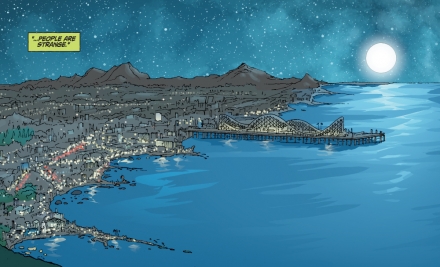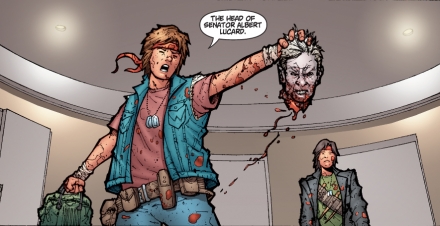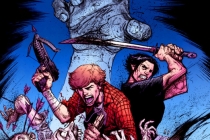Hunter Stephenson's Review: Lost Boys: Reign Of Frogs
Give or take, I am asked eight times a week by random pedestrians, "What is the best comic book adaptation that is not based on a comic book at all," and my hands begin to tremble every time. This causes the surface of my coffee to break into concentric circles like a mud puddle on Isla Nublar. I tend to quickly shuffle away from these inferior beings, while mumbling, "Obviously, The Lost Boys dude."
More than 20 years after The Lost Boys hit theaters, a much maligned straight-to-DVD sequel, Lost Boys: The Tribe, has entered the pop culture cloud; but far more interesting is that The Lost Boys and its original characters are now a comic book. Entitled Lost Boys: Reign of Frogs, the four-issue miniseries arrives via Jim Lee's Wildstorm (owned by DC Comics), and the issues serve as a direct sequel to Joel Schumacher's 1987 horror film, a looser prequel to this month's sequel and more. Whereas the DVD sequel recalls a Saved By the Bell spin-off co-starring Dustin Diamond (Corey Feldman and fans deserved much better), the comics are a respectable shot at giving casual and diehard fans (represented since 1999 at The Lost Cave) new developments, character arcs, and blood-letting. Plus, Edgar Frog hands the President of the United States a decapitated vampire head. It's pretty awesome.
The fact that writer Hans Rodionoff scribed both the comic book miniseries and the direct-to-DVD sequel reaffirms for the millionth time that Hollywood is a place where visions are greeted by more hands than an eager, campaigning politician.
Review continues after the jump with exclusive images from Reign of Frogs...Discuss: Have you guys checked out The Lost Boys comic books yet? If so, thoughts? If not, do you think the Frog Brothers are perfect for the medium?
Of the three issues reviewed here (the fourth wasn't made available to Slashfilm), the first issue of the series is the strongest, as it should be. Centering a comic book miniseries around Edgar Frog, a character practically created by Corey Feldman two decades ago, needs a really strong foundation. We are reintroduced to Edgar Frog in the present day, where he's a reclusive surfboard shaper who's buffed up considerably. Apparently, the likenesses of Feldman, Corey Haim's Sam Emerson, Kiefer Sutherland's David (yah, he appears) and Jamison Newlander's Alan Frog were a legal issue, though a physical resemblance to the actors remains throughout, especially in flashback. However, the dialogue is spot-on.
Rodionoff, working alongside penciller Joel Gomez and inker Don Ho, wisely and quickly expands the scope of the Frog Brothers' reality outside of their hometown of Santa Carla, California. Imagine if the brothers' most epic conspiracy theories about vampires were fully realized throughout history, dating back to the Masons, and you'll get an idea of what Rodionoff has envisioned. In this new medium, it's a trip to see these characters, circa 1990, on a financed mission to Washington D.C. to stake out members of the Senate. You can't help but pause, contemplate and laugh at how this would have played on film, even with the hypothetical benefits of a time machine.
The first issue also takes us back to Santa Carla, where we revisit the brothers' and their hippie parents' comic book shop and the ethereal boardwalk, complete with a customer having a timely discussion about Batman '89. The second issue basically tackles the "questions" that fans have about the first film's conclusion, ones involving the fate and vampness of key characters. Sam Emerson's canine, Nanook, gets a fresh kill, the gore flows and bad karma follows Edgar after he bogarts the double-stuffed Oreo cookies of Sam's Grandpa backat the old geezer's idyllic lodge. While far more could have been done to make this issue's thirsty vampire clan as memorable as the original film's and the kills could have been more clever, the storyline is agreeably faithful and entertaining.
Undoubtedly moving the storyline along to correlate with the new film, the third issue takes the most liberty with canon. As Sam Emerson becomes a peripheral character, his Grandpa unexpectedly moves to the plot's forefront, where Rodionoff deftly connects some dots regarding his taxidermy collection and mysterious motives, as hinted at back in '87.
Problems arise, however, when a character mentioned in the original film, but never seen, is actually shown and the action moves to a sex party happening at a mansion in a desolate part of the fictional coastal town. Essentially a nod to a once planned theatrical sequel called The Lost Girls (regardless of The Tribe, thankfully that didn't happen), Goth fashion and sensibility abounds, as do dyke punks, and one vampiress that's given dreadlocks and a pirate hat. Moreover, the leap of faith required to believe that the lead female vampire here is the same character mentioned in the '87 film was impossible for me, mostly due to the artwork. If this character and her fellow female fashion victims weren't disposed of in a worthy and succinct manner by the Frogs, their slippery appeal to the corniest of modern tastes might have derailed the series.
With the final issue dropping late August, as it stands, Lost Boys: Reign of Frogs successfully brings these characters (if not the actors) across the moat that generally separates movies and comic books (which is different from comics-to-film). It's rather absurd that a film with as many fans and widespread popularity as The Lost Boys would receive such a squandered movie sequel (even for a squandered movie sequel) so many years later, especially since Warner Bros. aggressively courted the fan base by hiring Feldman, Haim and Newlander.
With the comic books, Rodionoff has finally given new life to characters that many in the geek community didn't want to see fade away. And based on the issues reviewed here, it would be worthwhile for Wildstorm to greenlight further Frog Bros.' adventures, ones that are freed from the ties of DVD sequels and explore the scope presented in the debut issue. There are rumors that the Frog Brothers will face off with other creatures of the night, ones that would have proven too expensive for a film. Go for it.
7/10 – If you're a fan of the first film, these will make you smile.Sidenote: Why 1987's The Lost Boys feels like a great comic book adaptationJoel Schumacher's 1987 horror comedy is essentially a comic book on film, filled with indelible popomatic images: the muscular guido wailing on sax, "Eddie Munster" snarling in a corner, water guns inhaling holy water, death by stereo, the droopy, pre-stoned mouth of Corey Haim. Two of the film's most likable and obnoxious characters, the brothers Edgar and Alan Frog, are a jamboree of tough guy poses, winking one-liners, and heroic rescues straight off the racks. And if you want to go meta, these two protagonists live in a world where horror comics provide sacred commandments for mankind's survival. The hazy comic book store where the brothers work is owned by their hippie parents (who are straight out of a comic, in that they never move). The store's dusty rows of pulp provide the Frogs with a figurative fountain of youth to fend off the perma-young vampires invading their beach town. Schumacher's Santa Carla sparkles with mood—it's all in the details, the Missing Persons posters, the Amity -like billboards, the eye for fad fashions, the county fair-like smells—and its harshly lit afternoons, unsettling sundowns and debauched boardwalk nights place viewers on the stark time clock of a vampire while conjuring the passing of time in a way that mirrors illustrated panels.


